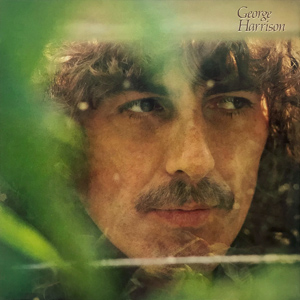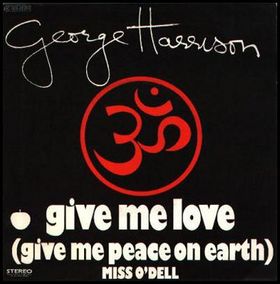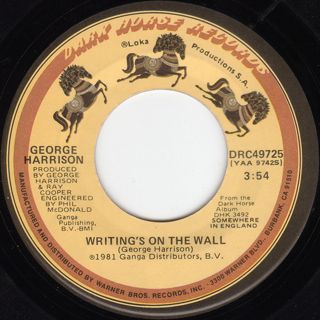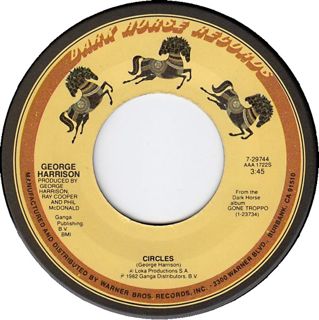
George Harrison is the eighth studio album by English rock musician George Harrison, released in February 1979. It was written and recorded through much of 1978, a period of domestic contentment for Harrison, during which he married Olivia Arias and became a father for the first time, to son Dhani. Harrison wrote several of the songs in Hawaii, while the track "Faster" reflected his year away from music-making, when he and Arias attended many of the races in the 1977 Formula 1 World Championship. The album also includes the hit single "Blow Away" and "Not Guilty", a song that Harrison originally recorded with the Beatles in 1968.

"Give Me Love " is a song by English musician George Harrison, released as the opening track of his 1973 album Living in the Material World. It was also issued as the album's lead single, in May that year, and became Harrison's second US number 1, after "My Sweet Lord". In doing so, the song pushed Paul McCartney and Wings' "My Love" from the top of the Billboard Hot 100, marking the only occasion that two former Beatles have held the top two chart positions in America. The single also reached the top ten in Britain, Canada, Australia and other countries around the world.

"Dark Horse" is a song by English rock musician George Harrison and the title track to his 1974 solo album on Apple Records. The song was the album's lead single in North America, becoming a top-20 hit in the United States, but it was Harrison's first single not to chart in Britain when issued there in February 1975. The term "dark horse" had long been applied to Harrison due to his unexpected emergence as the most accomplished solo artist of the four former Beatles following the band's break-up in 1970. In the song, however, he said he used the phrase in reference to gossip about someone who carries out clandestine sexual relationships. Commentators interpret the lyrics as a rebuttal to several possible detractors: Harrison's first wife, Pattie Boyd; reviewers who criticised the spiritual content of his 1973 album Living in the Material World; and his former bandmates John Lennon and Paul McCartney. Harrison named his Dark Horse record label after the song, and his 1974 North American tour with Ravi Shankar came to be known as the Dark Horse Tour.

"Love Comes to Everyone" is a song by English rock musician George Harrison from his 1979 album George Harrison. It is the opening track on the album and was also issued as the second single, after "Blow Away". The song reflects Harrison's contentment in his personal life as he was soon to become a father for the first time and married his second wife, Olivia Arias. Despite its commercial qualities, and contrary to some reviewers' predictions at the time of release, the song failed to become a hit.
"Far East Man" is a song written by English rock musicians George Harrison and Ronnie Wood, each of whom released a recording of the song in 1974. Wood's version appeared on I've Got My Own Album to Do, his debut solo album, and Harrison's on Dark Horse. Their only official songwriting collaboration, "Far East Man" is an affirmation of friendship in the face of life's obstacles and musically reflects the two guitarists' adoption of the soul genre. Written mostly by Harrison, the composition has been interpreted as a restatement of the humanitarian message expressed in his 1971 single "Bangla Desh", and a tribute to Indian musician Ravi Shankar.
"Don't Let Me Wait Too Long" is a song by English rock musician George Harrison, released on his 1973 album Living in the Material World. It was scheduled to be issued as a single in September that year, as the follow-up to "Give Me Love ", but the release was cancelled. Music critics have traditionally viewed "Don't Let Me Wait Too Long" as a highlight of the Material World album, praising its pop qualities and production, with some considering the song worthy of hit status.
"That Is All" is a song by English musician George Harrison released as the final track of his 1973 album Living in the Material World. A slow, heavily orchestrated ballad, it is one of many Harrison love songs that appear to be directed at either a woman or a deity. Harrison wrote and recorded the song during the height of his public devotion to Hinduism; on release, Rolling Stone described its lyrics as "a sort of Hindu In Paradisium".
"Marwa Blues" is an instrumental by English rock musician George Harrison. It was released on his final studio album, Brainwashed, in November 2002, a year after his death, and subsequently on a single as the B-side of "Any Road". The song is a slide guitar instrumental and named after Raga Marwa, an Indian classical raga traditionally played at sunset. "Marwa Blues" won the 2004 Grammy Award for Best Pop Instrumental Performance. Along with "Any Road" and the Brainwashed track "Rising Sun", it was also included on the 2009 compilation album Let It Roll: Songs by George Harrison.

"Hari's on Tour (Express)" is an instrumental by English musician George Harrison, released as the opening track of his 1974 album Dark Horse. It was also the B-side of the album's second single – which was "Ding Dong, Ding Dong" in North America and most other territories, and "Dark Horse" in Britain and some European countries. Among Harrison's post-Beatles solo releases, the track is the first of only two genuine instrumentals he released from 1970 onwards – the other being the Grammy Award-winning "Marwa Blues", from his 2002 album Brainwashed.

"Māya Love" is a song by English musician George Harrison, released on his 1974 album Dark Horse. The song originated as a slide guitar tune, to which Harrison later added lyrics relating to the illusory nature of love – maya being a Sanskrit term for "illusion", or "that which is not". Harrison's biographers consider the lyrical theme to be reflective of his failed marriage to Pattie Boyd, who left him for his friend Eric Clapton shortly before the words were written. Harrison recorded the song at his home, Friar Park, on the eve of his North American tour with Ravi Shankar, which took place in November and December 1974. The recording features Harrison's slide guitar extensively and contributions from four musicians who formed the nucleus of his tour band: Billy Preston, Tom Scott, Willie Weeks and Andy Newmark. Reviewers note the track as an example of its parent album's more diverse musical genres, namely funk and rhythm and blues, compared with the more traditional rock orientation of Harrison's earlier solo work.
"Beautiful Girl" is a song by English musician George Harrison, released on his 1976 album Thirty Three & 1/3. Harrison began writing the song in 1969 and considered recording it for his 1970 triple album All Things Must Pass. In its finished, 1976 form, the lyrics of "Beautiful Girl" were inspired by Harrison's second wife, Olivia Arias.
"Here Comes the Moon" is a song by English rock musician George Harrison from his 1979 album George Harrison. Harrison wrote the song while on holiday on the Hawaiian island of Maui in February 1978. His inspiration for the composition was the appearance of the moon in the evening sky, just as the sun was setting. Although the lyrics focus on this natural occurrence rather than on the symbolism it suggests, in the manner of Harrison's Beatles track "Here Comes the Sun", the song is seen as a sequel to that similarly titled piece.

"Soft-Hearted Hana" is a song by English rock musician George Harrison from his 1979 album George Harrison. In North America, it was also issued as the B-side of the album's lead single, "Blow Away", while in Britain and some other markets it was the B-side of the follow-up, "Love Comes to Everyone". The lyrics recall Harrison's experiences under the hallucinatory effects of magic mushrooms while holidaying on the Hawaiian island of Maui. The song title refers to Hana, a remote town on the island, and is a play on that of the 1920s ragtime tune "Hard Hearted Hannah".

"Soft Touch" is a song by English rock musician George Harrison from his 1979 album George Harrison. It was also issued as the B-side of the album's lead single, "Blow Away", in Britain and some other countries, while in markets such as North America, it was the B-side of the second single, "Love Comes to Everyone". Harrison wrote the song while in the Virgin Islands with his future wife, Olivia Arias, shortly before recording his 1976 album Thirty Three & ⅓. The song is a love song in which Harrison also conveys his wonder at the idyllic island setting.
"If You Believe" is a song by English musician George Harrison from his 1979 album George Harrison. Harrison began writing the song with Gary Wright on New Year's Day 1978 and finished the lyrics a month later while in Hawaii. The song appears as the final track on George Harrison. Its lyrics are a statement on the power of faith to bring about a desired outcome.

"Writing's on the Wall" is a song by English musician George Harrison from his 1981 album Somewhere in England. It was also the B-side of the album's lead single, "All Those Years Ago", which Harrison wrote as a tribute to his former Beatles bandmate John Lennon. In his lyrics, Harrison sings of the transient nature of life and the importance of recognising a spiritual purpose. Although the song was written long before Lennon's murder in New York in December 1980, the lyrics' reference to how easily friends can be shot down and killed led listeners to interpret it as a further comment on Lennon's death.

"Circles" is a song by English rock musician George Harrison, released as the final track of his 1982 album Gone Troppo. Harrison wrote the song in India in 1968 while he and the Beatles were studying Transcendental Meditation with Maharishi Mahesh Yogi. The theme of the lyrics is reincarnation. The composition reflects the cyclical aspect of human existence as, according to Hindu doctrine, the soul continues to pass from one life to the next. Although the Beatles never formally recorded it, "Circles" was among the demos the group made at Harrison's Esher home, Kinfauns, in May 1968, while considering material for their double album The Beatles.
"Ride Rajbun" is a song by English musician George Harrison. It was released in 1992 on the multi-artist charity album The Bunbury Tails, which was the soundtrack to the British animated television series of the same name. Harrison co-wrote the song's lyrics with Bunbury Tails creator David English. The eponymous Rajbun was a character in the series based on English's friend and cricketer Rajendrasinh Jadeja, one of a team of cricket-playing rabbits – in this case, from Bangalore in India. The composition is in the style of a nursery rhyme or children's song, while the all-Indian instrumentation on the recording recalls some of Harrison's compositions for the Beatles during 1966–68.
"Life Itself" is a song by English musician George Harrison from his 1981 album Somewhere in England. Harrison also included it on his 1989 greatest-hits compilation Best of Dark Horse. As a love song to God, the track served as the artist's most overtly religious musical statement since 1974. The lyrics offer praise to Christ, Vishnu, Jehovah and Buddha, thereby marking a return to the concept of a universal deity, regardless of religious demarcation, that Harrison had first espoused in his 1970 hit single "My Sweet Lord".
Songs by George Harrison 2 is a book of song lyrics and commentary by English musician George Harrison, with illustrations by Keith West and an accompanying EP of previously unreleased Harrison recordings. It was published in June 1992, in a limited run of 2500 copies, by Genesis Publications. As with Harrison and West's first volume, published in 1988, each copy was hand-bound and available only by direct order through Genesis in England.










